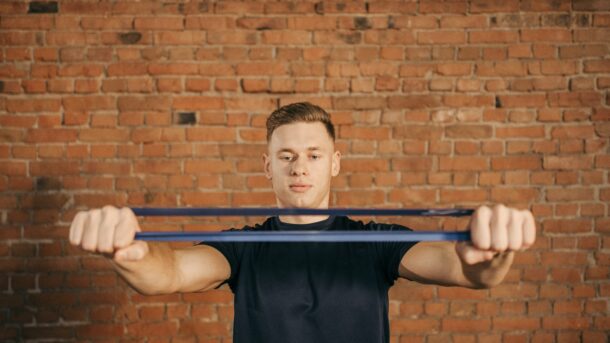Has anyone rehabbed their shoulder with resistance bands? I will be surprised if you haven’t heard about them. Introducing them into your workout routine help to provide extra resistance. Resistance bands help to strengthen the shoulder and also improve the tone of the rotator cuff muscles. They have two major features; portable nature and variety. Resistance bands are not your typical gym equipment which occupy much space and are relatively fixed. They are lighter and can be transported easily. They also come in different varieties. Resistance bands occur in different resistance levels as well as different colors. It follows that lighter-colored bands provide much lighter resistance. The benefits associated with the use of resistance bands explain the rise in their popularity.
What are Resistance Bands?
They are flat or tubular bands used as fitness tools for developing mobility, strength, and stability. Their use in exercise routines began in the 1990s. Originally made from surgical tubing, resistance bands are used as supports in heavyweights exercises. They also provide the same effectiveness as exercising with free weights. The different variants of resistance make it possible to use the right resistance requirement for an exercise. Resistance bands maintain tension during workouts. The added resistance that they provide makes the routine more challenging. Resistance bands are used essentially for rehabilitation. They are majorly used to restore mobility, flexibility, and functional strength of muscle groups post-injury.
How Do Resistance Bands Work?
Resistance bands work by introducing additional resistance, which correlates to the difficulty level of the exercise. The extra resistance is provided without the use of additional weight. In an exercise, the resistance force provided by the resistance band is counterbalanced by the force of your body weight which is the opposing force. Therefore when fitted in place, you are able to either push or pull against resistance. This way, you build up flexibility and strength without stressing the joints. The elastic nature of the bands allows you to focus and improve specific body parts. Therefore isolated muscle groups can be exercised without the risk of further injury. Blood supply is also improved. In a nutshell, resistance bands hasten the rehabilitation process.
Benefits of Resistance Bands
The alternate stretch of the resistance bands and muscle contraction help to improve tone. The tension created by the stretched band initiates muscle contraction. More stretch, more resistance, and the tougher the exercise becomes. In the long run, your endurance builds up. Resistance bands provide resistance independent of the force of gravity. This means all movements pertaining to an exercise can be performed. Regardless of your age and level of fitness, resistance bands are highly effective. Using resistance bands, many workout routines can be done while seated.
Final Word
Has anyone rehabbed their shoulder with resistance bands? Resistance bands are the most effective and highly recommended rehabilitation aid. Unlike weights, they exert no pressure on your joints. They restore muscle tone and functional strength. A return to full fitness post-injury occurs much faster using resistance bands.






Recent Comments